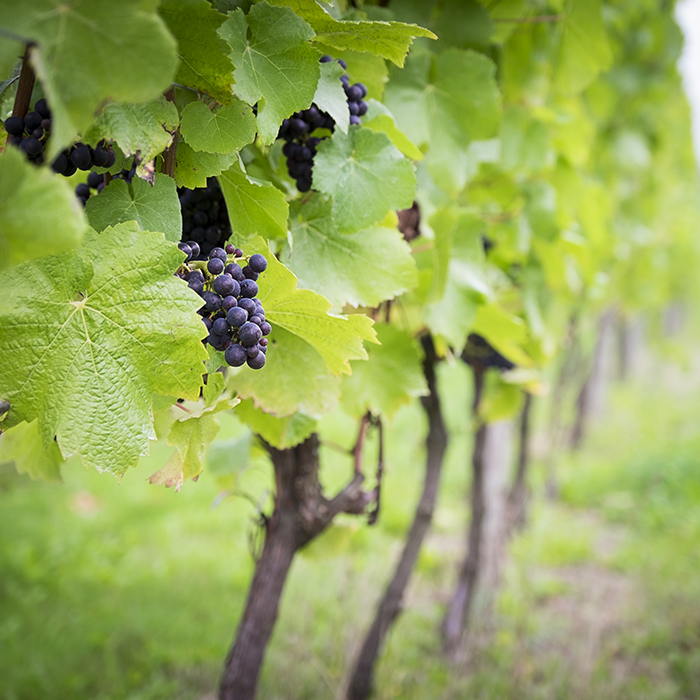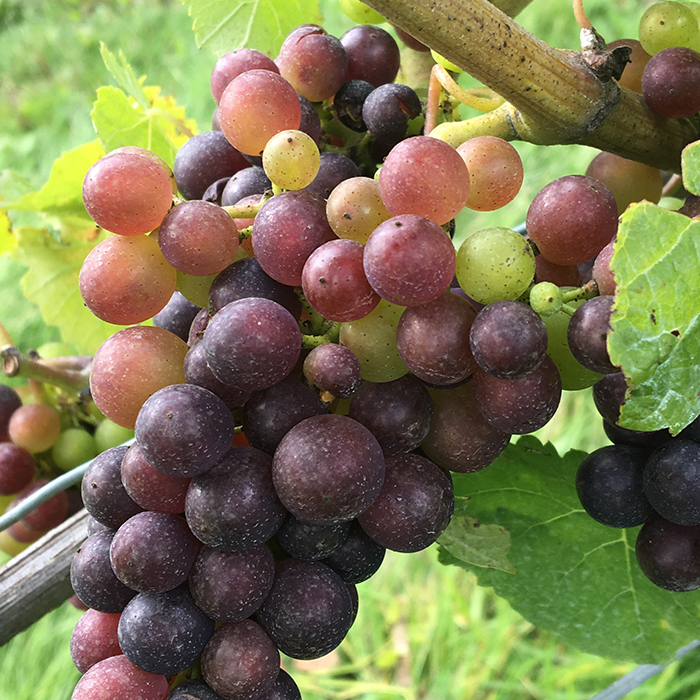Notes from the vineyard: véraison
Author: Guest Blogger

Pinot Noir vines that have completed véraison
Our vines are currently passing through véraison – a significant and interesting time in the growing season, marked most notably by the changing of colour in dark-skinned grape varieties like Pinot Noir and Meunier. Véraison is also when sugar begins to accumulate in the berries, acidity begins to drop, and it signals that harvest could begin in four to six weeks.
We start thinking about harvest much more regularly, and grape sampling gets underway, monitoring sugar and acidity development. At this stage, ripeness monitoring is done entirely in our winery lab – the grapes are far too tart to taste; picking decisions at Nyetimber, however, are made as much as possible on flavour. Analysis from the lab can inform Cherie (Spriggs) and I when we are approaching a window of ripeness, but we’ll soon start tasting the grapes regularly, and from that point flavour plays a big part in harvest decisions.
Véraison also gives us a chance to take stock of where we are in terms of the chronology of the growing season. As it happens, the early analysis of sugars and acidities this year indicates that we are equal or ahead of recent vintages at the equivalent point in the season. That is remarkable given the challenges we faced at the start of the growing season, but we have a warm and dry June and July to thank for that. Of course, one of the most critical phases of the growing season, in terms of quality, is yet to come.
The interval between véraison and harvest is where ripeness is achieved, and all flavour accumulation occurs. Over the next few weeks, berries go through a range of flavours and we’ll be monitoring for the disappearance of green flavours and then arrival of fruit flavours. An “absence of green” is the most important criterion to achieve, but – depending on the year – there can also be some delicious characteristics in the red-fruit spectrum for Pinots, and peach or ripe citrus flavours in Chardonnay.

A bunch of Pinot Noir grapes in the midst of véraison
Of course, the flavours found in grapes will be very different to those you find in a bottle of sparkling wine, thanks to two fermentations and a long period of ageing. It’s with experience that one gets to know the sort of flavours a vineyard block can produce, and how those translate into finished wines. But the basic principle is that delicious grapes yield delicious juice, that turns into delicious wine. I think some producers assume that fermentation and ageing are corrective processes and therefore don’t put enough emphasis on grape tasting, at least in the world of sparkling wine.
We use only estate-grown grapes for Nyetimber and, although we grow just three grape varieties, we have over 80 different parcels across our eight vineyards. These parcels are in part defined by technical reasons (site, clone, rootstock), but also by the flavours that we have identified in the vineyard and the resulting base wines. Tasting the diversity in flavours from these parcels is something that I look forward to every year. That diversity is also, I believe, one of the greatest influences on the quality of our wines.
While the final phases of ripening are occurring, we are busy getting things ready in the winery and vineyard for receiving the harvest. That means a lot of preparatory work and cleaning, including getting all our picking crates ready, tanks cleaned and equipment tested. We are working towards a harvest ready date of October 2nd – meaning everything needs to be finalised by then in case we need to start. That date will be refined once we can see the trend in rate of berry ripening.
By the time I write my next post we should be in the middle of harvest, and I’ll hopefully be able to update you on what the 2017 vintage is delivering.
Find out more about Nyetimber on bbr.com and read Brad’s previous posts here.


